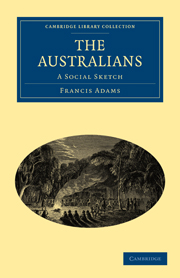I - “UP COUNTRY”
Published online by Cambridge University Press: 07 October 2011
Summary
A thousand minor particulars of fauna and flora clear to the eye of the naturalist do not impair the great fact of the extraordinary general resemblance of the whole Interior of Australia.
And the action of man has tended, and is ever tending, more and more to accentuate this resemblance.
Pastoralism, beginning with cattle and continuing with sheep, the rabbit following swiftly in their train from south to north, has, thanks to reckless overstocking and a system of tree-destruction equally reckless, pressed a pitiless stamp of desolation on to the face of the whole land.
The natural grasses, with all their wonders of luxuriance and lovely flowering, have had whole genera destroyed—eaten out at the roots by the famishing animals.
Only clumps of the wiriest herbage—tussocks, as they are called, something like the tufts of razor-like keenness of edge which grow on English sand-dunes, shrivelled and blasted with the brine—survive into the severe seasons.
Nothing more mournful than the great plains, treeless and grassless, that are to be found all over Australia.
The pallid sky without a cloud oppresses you with its intolerable burthen, and your eyes ache with looking towards the viewless horizon smoking like a cauldron.
Often there is no sign of life whatever.
Man has exterminated the kangaroo and the emu, and even the dingo, as much with overstocking as with lead and strychnine.
- Type
- Chapter
- Information
- The AustraliansA Social Sketch, pp. 135 - 142Publisher: Cambridge University PressPrint publication year: 2011First published in: 1893



